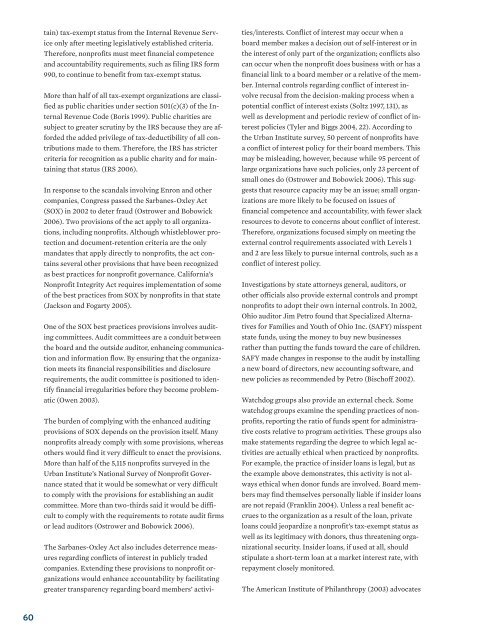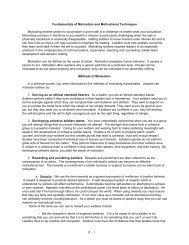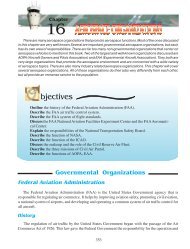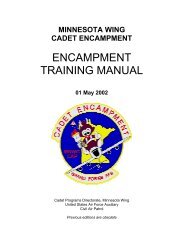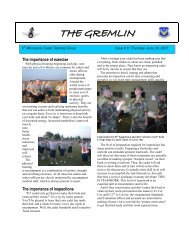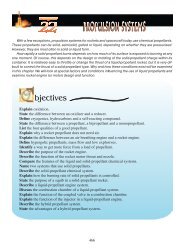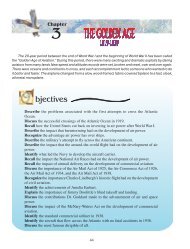tain) tax-exempt status from the Internal Revenue Serviceonly after meeting legislatively established criteria.Therefore, nonprofits must meet financial competenceand accountability requirements, such as filing IRS form990, to continue to benefit from tax-exempt status.More than half of all tax-exempt organizations are classifiedas public charities under section 501(c)(3) of the InternalRevenue Code (Boris 1999). Public charities aresubject to greater scrutiny by the IRS because they are affordedthe added privilege of tax-deductibility of all contributionsmade to them. Therefore, the IRS has strictercriteria for recognition as a public charity and for maintainingthat status (IRS 2006).In response to the scandals involving Enron and othercompanies, Congress passed the Sarbanes-Oxley Act(SOX) in 2002 to deter fraud (Ostrower and Bobowick2006). Two provisions of the act apply to all organizations,including nonprofits. Although whistleblower protectionand document-retention criteria are the onlymandates that apply directly to nonprofits, the act containsseveral other provisions that have been recognizedas best practices for nonprofit governance. California’sNonprofit Integrity Act requires implementation of someof the best practices from SOX by nonprofits in that state(Jackson and Fogarty 2005).One of the SOX best practices provisions involves auditingcommittees. Audit committees are a conduit betweenthe board and the outside auditor, enhancing communicationand information flow. By ensuring that the organizationmeets its financial responsibilities and disclosurerequirements, the audit committee is positioned to identifyfinancial irregularities before they become problematic(Owen 2003).The burden of complying with the enhanced auditingprovisions of SOX depends on the provision itself. Manynonprofits already comply with some provisions, whereasothers would find it very difficult to enact the provisions.More than half of the 5,115 nonprofits surveyed in theUrban Institute’s National Survey of Nonprofit Governancestated that it would be somewhat or very difficultto comply with the provisions for establishing an auditcommittee. More than two-thirds said it would be difficultto comply with the requirements to rotate audit firmsor lead auditors (Ostrower and Bobowick 2006).The Sarbanes-Oxley Act also includes deterrence measuresregarding conflicts of interest in publicly tradedcompanies. Extending these provisions to nonprofit organizationswould enhance accountability by facilitatinggreater transparency regarding board members’ activities/interests.Conflict of interest may occur when aboard member makes a decision out of self-interest or inthe interest of only part of the organization; conflicts alsocan occur when the nonprofit does business with or has afinancial link to a board member or a relative of the member.Internal controls regarding conflict of interest involverecusal from the decision-making process when apotential conflict of interest exists (Soltz 1997, 131), aswell as development and periodic review of conflict of interestpolicies (Tyler and Biggs 2004, 22). According tothe Urban Institute survey, 50 percent of nonprofits havea conflict of interest policy for their board members. Thismay be misleading, however, because while 95 percent oflarge organizations have such policies, only 23 percent ofsmall ones do (Ostrower and Bobowick 2006). This suggeststhat resource capacity may be an issue; small organizationsare more likely to be focused on issues offinancial competence and accountability, with fewer slackresources to devote to concerns about conflict of interest.Therefore, organizations focused simply on meeting theexternal control requirements associated with Levels 1and 2 are less likely to pursue internal controls, such as aconflict of interest policy.Investigations by state attorneys general, auditors, orother officials also provide external controls and promptnonprofits to adopt their own internal controls. In 2002,Ohio auditor Jim Petro found that Specialized Alternativesfor Families and Youth of Ohio Inc. (SAFY) misspentstate funds, using the money to buy new businessesrather than putting the funds toward the care of children.SAFY made changes in response to the audit by installinga new board of directors, new accounting software, andnew policies as recommended by Petro (Bischoff 2002).Watchdog groups also provide an external check. Somewatchdog groups examine the spending practices of nonprofits,reporting the ratio of funds spent for administrativecosts relative to program activities. These groups alsomake statements regarding the degree to which legal activitiesare actually ethical when practiced by nonprofits.For example, the practice of insider loans is legal, but asthe example above demonstrates, this activity is not alwaysethical when donor funds are involved. Board membersmay find themselves personally liable if insider loansare not repaid (Franklin 2004). Unless a real benefit accruesto the organization as a result of the loan, privateloans could jeopardize a nonprofit’s tax-exempt status aswell as its legitimacy with donors, thus threatening organizationalsecurity. Insider loans, if used at all, shouldstipulate a short-term loan at a market interest rate, withrepayment closely monitored.The American Institute of Philanthropy (2003) advocates60
eform measures to make boards more independent,more engaged in oversight, and more aware of the implicationsof their decisions. Board members should receivetraining on how to interpret financial reports, how to exerciseoversight of budgetary matters, how to make decisionson employee and executive compensation, and howto treat staff and volunteers. In addition, state attorneysgeneral are empowered to enforce board duties of careand loyalty (Brody 2002).In order to ensure greater accountability to donors, somenonprofit advisory groups propose that nonprofits adopta donor’s bill of rights. The ten recommendations requirethat organizations disclose how they will use donatedfunds, provide the identities of the board members, andshare their most recent financial statements. The bill ofrights also requires nonprofits to assure donors that theirdonations will be used for the stated purposes for whichthey were given, to properly recognize donors, and to ensurethat donations are handled with confidentiality. Finally,donors should be informed of whether thoseseeking donations are volunteers, staff, or hired marketers,and they should feel free to ask questions and receiveforthright answers when making donations (Watson2000).The Johns Hopkins Nonprofit Listening Post Project—aMarch 2005 survey of 443 organizations with 207 respondents—foundthat 93 percent of nonprofits distributefinancial statements to their boards on a quarterly basis,and 62 percent share them every month. Seventy-fourpercent make their financial reports available to membersof the public upon request, 70 percent distribute them todonors, and 54 percent publish their statements in annualreports. Nine percent post financial reports on their organizationalWeb sites (Salamon 2005). These results indicatethat a great many nonprofit organizations arecommitted to achieving accountability, by means in excessof what is required by law. Such internal commitmentto ethical values bodes well for the achievement ofintegrity in nonprofits.Achieving Reciprocity (Level 3)A match between donor interests and the nonprofit’s missionis critical to achieving reciprocity. As nonprofitsevolve, they become more professional in orientation andoutlook. It follows, therefore, that they will become moreattuned to their mission and their relationship to thecommunity as a whole. Chasing funding sources withouta clear connection to mission weakens the organization,impedes reciprocity, and opens the organization to scandal.In 2003, the Kids Wish Network—a nonprofit establishedto offer comfort and hope to children with terminal orlife-threatening illnesses—collected $205,255 in donationsin New York through the work of professionalfundraisers. After the fundraisers were paid, a mere 12percent ($24,634) was retained by Kids Wish Network. Ina spot check of 607 fundraising campaigns in 2002, the attorneygeneral of New York found eight other professionalfundraisers that turned over a meager 12 percent ofproceeds to the charitable organization for which theywere raised (Gormley 2003).The American Institute of Philanthropy and the BetterBusiness Bureau recommend that charities keep at least65 percent of the monies raised by the professionals. Alaw enacted in California institutes more protections forconsumers, making nonprofits more accountable for hiringfundraisers (Gormley 2004). For example, the MarylandAssociation of Nonprofits recommends thatorganizations work to ensure that over a period of aboutfive years, on average every dollar spent on fundraisingshould be matched by raising at least three dollars(Causer 2004; Salmon 2004).Many believe that making charities profitable forfundraisers erodes the principle of reciprocity—that is,that nonprofits should be responsive to donors and designatedconstituencies. External controls in this area arelimited because the U.S. Supreme Court has consistentlyinvalidated state laws that place numerical limits onfundraising ratios on the grounds that such limits are toorestrictive of free speech and association. Most states provideethical guidelines and publicize fundraising ratios(Bryce 2005), but achieving reciprocity ultimately requiresinternal control. Nonprofits that employ Grace’s(2006) development approach to resource attainment aremore likely to achieve reciprocity by cultivating donor-investorswho support and contribute to the mission of theorganization.Although not-for-profits are prohibited from using federalgrant or contract funds for lobbying activity, Congressand the Internal Revenue Service (IRS) generallysupport advocacy activities (including lobbying with privatefunds) by nonprofits. The Tax Reform Act of 1976clarified and expanded the scope of lobbying activity permissibleby 501(c)(3) organizations, specifically by narrowingthe legal definition of lobbying subject torestriction. Lobbying is differentiated from other advocacyactivity because it occurs only when there is an expenditureof funds by the not-for-profit organization foractivities aimed specifically at influencing legislation. Advocacyinvolves providing information in an effort to educateabout and promote an issue or overall policyresponse (“Charity Lobbying” in the Public Interest, n.d.;61
- Page 1 and 2:
VOLUME FOUR STRATEGIC PERSPECTIVESL
- Page 3 and 4:
VOLUME FOUR STRATEGIC PERSPECTIVESL
- Page 5 and 6:
VOLUME FOUR STRATEGIC PERSPECTIVESL
- Page 7:
VOLUME FOUR STRATEGIC PERSPECTIVESL
- Page 10 and 11:
12CHAPTER 12INTRODUCTION TO STRATEG
- Page 12 and 13: 12.1 Strategic Leadership: Defining
- Page 14 and 15: mandates or resolutions that would
- Page 16 and 17: and ambiguity, aspiring strategic l
- Page 18 and 19: 12.2 National Security StrategyThe
- Page 20 and 21: within our borders has always been
- Page 22 and 23: front common challenges like violen
- Page 24 and 25: and our strategy, not sector earmar
- Page 26 and 27: thinking about organizations. She m
- Page 28 and 29: A systemic approach to failure is m
- Page 30 and 31: The late W. T. Grant Company is a r
- Page 32 and 33: the resources - setting the directi
- Page 34 and 35: focal point for describing and inte
- Page 36 and 37: Consequently, we do not restrict th
- Page 38 and 39: paragraphs, Web pages, then edit an
- Page 40 and 41: Web, can be viewed as a CS attempt
- Page 42 and 43: How to evaluate users and contribut
- Page 44 and 45: 13CHAPTER 13LEADING PUBLIC &VOLUNTE
- Page 46 and 47: 13.1 Leadership for Volunteers:The
- Page 48 and 49: 13.2 Take Root: Volunteer Managemen
- Page 50 and 51: QualificationsClearly list educatio
- Page 52 and 53: and effectively track their volunte
- Page 54 and 55: • Understand rules for recognitio
- Page 56 and 57: • Send a birthday card.• Submit
- Page 58 and 59: and tested more than six decades af
- Page 60 and 61: specific interests of the donors, v
- Page 64 and 65: Smucker, 1999).The Internal Revenue
- Page 66 and 67: culture is necessary to ensure the
- Page 68 and 69: 13.4 The New Look of TransparencyBy
- Page 70 and 71: ees for a couple of reasons: One, i
- Page 72 and 73: 13.5 Public and Private Management:
- Page 74 and 75: TABLE 1:FUNCTIONS OF GENERAL MANAGE
- Page 76 and 77: 3. Career System. The model corpora
- Page 78 and 79: islative charter - the Clean Air Ac
- Page 80 and 81: In controlling performance, Chapin
- Page 82 and 83: 14CHAPTER 14AIRPOWER ASSTRATEGIC LA
- Page 84 and 85: 14.1 Strategic Air Power: Fulfillme
- Page 86 and 87: carry it out. Their daylight raids
- Page 88 and 89: you did not rely on strategic bombi
- Page 90 and 91: 14.2 Warden and the Air Corps Tacti
- Page 92 and 93: ecomes one of applying sufficient i
- Page 94 and 95: tification, and a Jominian claim to
- Page 96 and 97: courage the rapid and widespread ex
- Page 98 and 99: it to influence physical players in
- Page 100 and 101: 14.4 Basic Air Force DoctrineAF Doc
- Page 102 and 103: earthquake-stricken Haiti. The worl
- Page 104 and 105: perspective. Airmen do not divide u
- Page 106 and 107: Command and ControlCommand and cont
- Page 108 and 109: 14.5 Should the US Maintain the Nuc
- Page 110 and 111: form of human government.” 20 Dem
- Page 112 and 113:
obtainable goal. See the Global Zer
- Page 114 and 115:
15CHAPTER 15ORGANIZATIONAL CULTURE
- Page 116 and 117:
15.1 Organizational CultureBy Doria
- Page 118 and 119:
Review. This action strives to unco
- Page 120 and 121:
gram will serve and then having the
- Page 122 and 123:
ticipating the changes being made b
- Page 124 and 125:
Many years of working with change p
- Page 126 and 127:
At the least, the areas of concern
- Page 128 and 129:
15.4 Developing an Innovative Cultu
- Page 130 and 131:
CONCLUDING THOUGHTSIn an ever-chang
- Page 132 and 133:
global issues. Businesses that poss
- Page 134 and 135:
— Sees the big picture—the shif
- Page 136 and 137:
16CHAPTER 16STRATEGIC COMMUNICATION
- Page 138 and 139:
16.1 Principles of Strategic Commun
- Page 140 and 141:
16.2 The Art of NegotiationBy Brend
- Page 142 and 143:
16.3 Negotiating Effectively Across
- Page 144 and 145:
hidden areas can act as cultural ho
- Page 146 and 147:
and four conflict styles. Hammer be
- Page 148 and 149:
maintaining the relationship. As th
- Page 150 and 151:
25 Mitchell R. Hammer, “Chapter 1
- Page 152 and 153:
tural, socioeconomic, and psycholog
- Page 154 and 155:
for the win-win," during which time
- Page 156 and 157:
interests and, at worst, as a gun s
- Page 158 and 159:
Public diplomacy is surely about mu
- Page 160 and 161:
But public diplomats do not have th
- Page 162 and 163:
Photo courtesy of the familyThe LEA
- Page 164:
THE CADET OATHI pledge that I will


